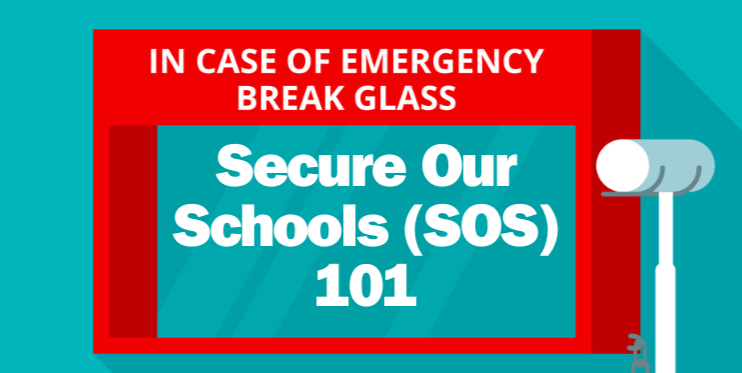Authors’ note: As a police chief and a high school principal, we worked together with the support of Dr. Emily Lembeck, a visionary superintendent, for nine years to ensure our school’s safety in an urban-suburban Georgia town. In the wake of the most recent school shootings, we feel compelled to share some essential best practices for immediate consideration as schools move forward into the 2022–2023 school year.
Essential steps for leaders in a post-uvalde world
Over the last two years in America, we have experienced the COVID pandemic, extensive and divisive political turmoil, and widespread violence. In totality, these events have caused various degrees of apathy and distraction in communities and schools. As we were preoccupied with the overarching issues dominating the headlines, the unthinkable massacre in Uvalde, Texas, shook us from our malaise and created calls for action.
We must now accept that responsible school and police leaders need to regroup, set aside any lingering ideological or political differences, and acknowledge that securing our schools is not only crucial but also transcends political discourse. School and police leaders must, in good spirit, collaborate to create and nurture an ecosystem capable of saving our schools from future atrocities. In this blog post, we will start with the essentials that you can act upon immediately.
Addressing the complexities and rebuilding trust
In many places, local school board meetings have become ground zero for culture wars regarding COVID protocols, politics, curriculum, parent input, race relations, and sexual and gender identity. At the same time, police have been defunded, demonized, understaffed, and figuratively handcuffed. Some school districts hotly debate the presence, role, and arming of police in schools.
The relational trust between parents and students toward their schools and toward law enforcement agencies has suffered, and once again we find ourselves emotionally reeling from a school shooting. With renewed intentionality, we must respond to the multifaceted challenges of keeping students safe in school. It is imperative for schools and law enforcement to create a sense of community where students, parents, staff, and citizens will ask for help, report concerns, and respond as needed during a crisis. Now, perhaps more than ever before, this work will prove to be challenging.
A call to partnership
As school systems and law enforcement agencies work together to strengthen their relationship and create a Secure Our Schools (SOS) ecosystem, it is critical for both agencies to engage in transparent and forthcoming communication regarding school and community concerns, demonstrate competency, and publicly share responsibility. There must be ongoing strategic planning between schools and their police as it is important to articulate and clarify perspectives, goals, and the unique roles of each agency.
In addition to trust building, schools and law enforcement must work together to provide interactive training to students and faculty in recommended civilian responses regarding the prevention of school violence as well as what to expect and what to do during an active shooter incident.
Through mutually beneficial communication and training, school systems and police departments will fashion a common mindset, develop the connective tissue of relational trust, and grow the muscle memory needed to mitigate school violence or jointly respond in a crisis. Together, law enforcement and educators will increase their capacity to safeguard our children, families, and community.
Where do we go from here?
Considering what we are learning from the Uvalde tragedy, we must reassert some of the basics and embrace the foundational, honest conversations that are essential between schools and their respective law enforcement agencies. While it is clear a fully developed Securing Our Schools (SOS) ecosystem will evolve through robust team building and layers of collaboration between school and law enforcement leaders, America’s current state of preparedness to repel school shooters is not up to the level it needs to be in the 2022 climate.
An immediate reset is needed for the upcoming school year, and there is no time to lose. School and law enforcement leaders must have transparent and clear communication to create and/or confirm a clear understanding of expectations, actions, and incident command.
As we discuss in our article, “Creating a Secure Our Schools (SOS) Ecosystem,” a deep, comprehensive, and potentially time-consuming review of policies, procedures, and programming is in order, but with the more immediate time frame of opening schools in the coming weeks, the following action items are necessary and must be taken as soon as possible:
POLICE
1. Establish a clear standard for law enforcement actions at active shooter events (ASE).
The standard for law enforcement personnel who arrive at the scene of an ASE is to immediately enter the school and confront the shooter and stop the killing. While this imperative has been in place for over 25 years, most officers have only been trained in it sporadically and it has rarely found its way into police rules or policies.
The time is now for law enforcement leaders to agree on this as the gold standard for action, then train officers and deputies in its vital importance and let them know they will be held accountable for performing this duty consistent with their oath of office.
The Commission for the Accreditation of Law Enforcement Agencies (C.A.L.E.A.), which sets national standards for law enforcement, and state law enforcement training organizations should make codifying this standard a top priority.
2. Establish a clear standard requirement for law enforcement officers arriving at the scene of an ASE to establish a basic form of incident command to restore order and provide an organized response to the event.
The most typical scenario for an ASE involves multiple officers from multiple law enforcement agencies arriving almost simultaneously. At the same time, news media, emergency medical personnel, frantic parents, and others tend to arrive as school leaders are also attempting to respond to needs while searching for information and direction.
The most immediate result is nearly always on-scene chaos among all responders. The Incident Command System (ICS) is designed to bring order from chaos during the deepest of emergency situations as well as the aftermath.
There are variations of ICS, some of which become quite complicated, e.g., the National Incident Management System (NIMS); however, given the volume of turnover in police agencies, and large-scale emergencies being few and far between, officers of all ranks are prone to forget or may not have the leadership qualities to seize command in a crisis. Therefore, it is best to utilize, train, and require officers to use a very basic ICS model with the following roles:
-
- Incident Commander (IC) – Assumes overall command and coordination of the scene and attends to providing the five Cs of emergency management (Command, Containment, Communications, Coordination, and Critique). The Incident Commander should be from the primary jurisdiction of the incident and be the highest-ranking police supervisor or a senior member of the primary agency. The IC assigns the following subordinate commanders and coordinates their missions with one another.
-
- Operations Commander – Takes charge of operations, sets up entry team(s), establishes appropriate perimeters, and directs deployment of police personnel evacuations while the scene is “hot.”
-
- Logistics Commander – Takes charge of requesting and providing logistics such as SWAT Teams, bomb disposal units, triage and transportation of any injured, temporary gathering and sheltering of evacuees (with school personnel), and establishment of staging areas for responders.
-
- Communications Commander – Takes charge of all lines of communication—radio, chain of command, news media, school personnel, responding agencies, etc. They also compile necessary data about the incident and coordinate press conferences, interviews, and single-point public information flow. The Communications Commander coordinates closely with the school system’s communications point of contact.
-
- Planning Commander – Takes charge of planning and coordinating next steps in all other areas.
All commanders may assign available law enforcement personnel they need to complete their missions and accomplish their goals under difficult circumstances unless they are formally relieved of their duty by a higher-ranking police authority.
All law enforcement supervisors should be trained in ICS through classroom training, tabletop exercises, and full-scale exercises.
3. Establish clear investigative protocols for following up on reports of individuals who fit the profile of aspiring school shooters for purposes of preventing possible escalation.
In the aftermath of many school shootings, investigation reveals that in the months leading up to the attack, there were indications in terms of threats, social media statements, and/or stockpiling weapons by the shooter. The police (and FBI) are often accused of not doing enough to stop the individual, while the police counter that the individuals have constitutional rights and if they have not yet committed a crime, there are limitations on what the police can do to limit their freedom.
However, police have legal measures at their disposal for investigating suspicious circumstances, including:
- Voluntary interviews of the suspect, family, and associates
- Legal reviews of social media correspondence
- Periodic surveillance
- Investigative grand juries
- Searches when probable cause exists
- Both voluntary and involuntary mental health evaluations when the suspect appears to be a threat to themselves or others
Police departments need to develop written confidential policies and procedures specifically for following up on potential school shooters.
School systems
1. Train all school faculties in emergency plans and procedures, including prescribed interactions with law enforcement personnel during an ASE
Through natural employee attrition coupled with two years of disruption due to COVID, many faculty members have not had refresher training, or have never had training, in school emergency procedures. School leaders will want to review these procedures with their school resource officers and local LE agencies and seek timely feedback. To protect students during this upcoming year, schools must make the training and retraining of their staff and students a priority at the beginning of the school year.
2.Review/refresh training related to civilian response to an active shooter
In the years leading up to 2020, there were several large-scale tragic school shootings. As a result, there was a great deal of tactical training for police and school personnel; active shooter training programs for the public, e.g., Civilian Response to Active Shooter Event (CRASE) training and Stop the Bleed; and interactive and joint agency trainings on-site at schools. Due to school closings, staff attrition, and a potential lack of focus on these protocols, all need to be updated and reviewed. Additionally, review protocols for reporting concerns whenever someone within the school environment (staff, students, parents, or administrators) becomes aware of an individual presenting themselves as a potential threat.
3. Assess and improve physical plant security of schools.
Notwithstanding the school security training that needs to occur as soon as possible, all school buildings need immediate assessments in terms of Crime Prevention Through Environmental Design (CPTED). CPTED evaluates buildings for points of ingress and egress, camera systems, lighting, signage, etc. Many law enforcement officers are trained in conducting the CPTED process and making confidential recommendations to school administrators. Meanwhile, law enforcement tactical personnel (SWAT) are proficient in conducting hazard vulnerability assessments (HVAs) in addition to CPTED assessments. HVAs evaluate ways an attacker may breach school security and develop countermeasures to prevent or repel attacks. HVAs must also be a priority for schools in 2022.
The critical partnership between education and law enforcement
Uvalde, Texas, isn’t the most recent school intrusion or potential school shooter incident in the United States. Others have thankfully concluded differently and with less tragic impact. And there will be future incidents. Public safety and school communities must work together and emerge from the trauma of Uvalde with a renewed sense of purpose and dedication toward school and community safety.
Deep collaboration and partnership between schools and law enforcement is the right work, right now. As we acknowledge our children, our families, and our schools are struggling, educational leaders must actively and publicly partner with law enforcement to ensure our students and staff receive our best effort regarding safe schools and communities.
We all know that in a worst-case scenario, there will be shared responsibility and accountability. Now is the time for leaders in education and law enforcement to demonstrate the vision and the capacity to address the challenges, build the relationships, and implement the training that will secure our schools.







